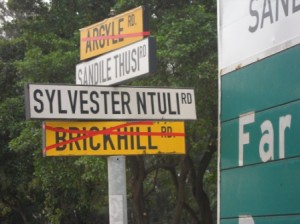South Africa: the Fight to take down Apartheid-era Landmarks
Black South Africans are starting to dethrone Apartheid-era leaders, immortalised in statues and street signs. In these reports for CBC Radio and the Toronto Star, I uncover the quiet fight for South Africa’s landmarks.
Activists and municipalities are starting to re-name them or take them down altogether.
But some white South Africans are angry, and are not letting them go without a fight.
TORONTO STAR
South Africa’s street signs, place names lead to more struggle
28 May, 2010
Block by block, South Africa’s street signs are changing. Afrikaans and European names like Verwoerd and Gardiner are making way for Malibongwe and KaSeme.
Busts and statues of colonial and apartheid-era leaders are being replaced with the likes of those who resisted them, or died trying.
Next week, politicians, academics and local residents will meet to discuss changes to place names in Kimberley, in the middle of the country. It’s the last in a series of nationwide hearings, where South Africans now have a say in naming the environment around them.
Each city has taken a different approach. “The biggest impact has been in Durban,” says Elwyn Jenkins, author of Falling into Place: The Story of Modern South African Place Names.
“Nearly all of the major streets downtown and in the central suburban areas have been renamed.” While the old names remain on Durban’s street signs — conspicuously crossed out by red tape — the new names are posted just above them, to allow people to adjust.
Not so in Johannesburg, where the transition has been swift, and for some, disorienting.
“You drive around and you’re looking for an address, and all of a sudden you look up and there you see a name you don’t know!” says Fanie Terblanche, chairman of the Federation of South African Tourist Guide Associations.
As mapmakers struggle to keep up, Terblanche advises the more than 350,000 World Cup visitors expected next month to forego road maps for the up-to-date GPS.
Not long ago the name Johannes (Hans) Strijdom — former prime minister, Afrikaner nationalist and advocate of racial segregation — could be found stamped on street signs throughout the country.
But in 2001, an underground parking garage collapsed under Pretoria’s Strijdom Square, bringing his bust crashing to the ground. It was perhaps an omen of things to come.
The square now bears the name of Lilian Ngoyi, the anti-apartheid activist who, in the 1950s, led marches against laws requiring blacks to carry identification, particularly to enter white areas.
But just outside Pretoria, little has changed. Hans Strijdom Dr. winds for more than 20 kilometres, the large green and white highway signs a lingering emblem of the apartheid era.
For Khorombi Dau, member of the Mayoral Committee for Sport, Recreation, Arts and Culture in the municipality of Tshwane, too many such reminders remain.
“Those names should be removed,” he says. “They belong to a dark part of our history.”
As the white minority government was swept out of office in 1994 and replaced by Nelson Mandela and the African National Congress, an increasing, but still modest, number of Afrikaans and European names were replaced by African ones. But they haven’t changed without a fight.
Public hearings in Pretoria ended in chaos in 2008. Name-change proposals met with howls of derision from members of the Afrikaner community. Young men erupted into racist songs, and prevented people from speaking.
Conrad Beyers, a Freedom Front Plus councillor and member of Tshwane’s Public Place and Street Names Committee, says local governments are targeting Afrikaner heroes and replacing them with the names of ANC party stalwarts.
“They’re changing the heroes of one community to the names of the heroes of another community,” he says. “We say that is not a solution.”
Opposition parties have taken the government to court over plans to rename towns and cities, including a proposal to change the name of the capital, Pretoria, to Tshwane. The government quietly retracted an announcement of the change.
In last year’s State of the Nation address, South African President Jacob Zuma pledged to take a “common national approach to the changing of geographic and place names,” and to “involve all South Africans in forging an inclusive national identity.”
Government efforts to mollify slighted whites while making a break with the past is proving a difficult line to tread. The Tshwane Royal House, who claim to be descendants of King Tshwane, held a news conference to urge the government to press ahead with the capital’s name change.
“It seems government is so eager to pander to the tantrums of a tiny white Afrikaner minority, at the expense of the black majority who have fought so hard for liberation,” read a statement by the Executive Committee.
But Afrikaner groups applaud the status quo, which they call a compromise: the capital, Pretoria based in the city of Tshwane.
Since 1994, South Africa’s history has been forged with creative compromise. The old province, Natal, is now KwaZuluNatal. The official languages, once only Afrikaans and English, now number 11.
The national anthem, previously sung only in Afrikaans, is now a combination of Die Stem and Nkosi Sikelel’ iAfrika, and is sung in five languages.
Despite discord and disparate interests, all signs point to a country that will continue to emerge from the shadows of its apartheid past.


